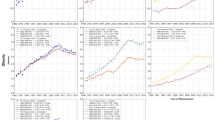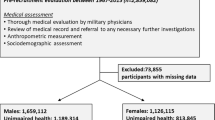Abstract
Background/Objectives:
Childhood obesity increases the risk for adult obesity and diseases. The aim of this study was to investigate secular changes of childhood body mass index (BMI), overweight and obesity in boys born during 1946–2006, using the population-based BMI Epidemiology STudy (BEST) cohort in Gothenburg, Sweden.
Subjects/Methods:
We collected height and weight from archived school health records for boys born every 5 years 1946–2006 (birth cohort 1946 n=1584, each birth cohort 1951–2006 n=425). Childhood BMI at 8 years of age was obtained for all the participants.
Results:
Childhood BMI increased 0.18 kg m−2 (95% confidence interval: 0.16–0.20) per decade increase in birth year, during 1946–2006. The increase was significant from birth year 1971, peaked 1991 and was then followed by a stabilization or tendency to a reduction. Next, we aimed to thoroughly explore the trend after birth year 1991 and therefore expanded birth cohorts 1991 (n=1566), 2001 (n=6478) and 2006 (n=6515). Importantly, decreases in mean BMI (P<0.01), prevalences of overweight (P<0.01) and obesity (P<0.05) were observed after birth year 1991. For boys born in Sweden and with parents born in Sweden, a substantial reduction in the prevalences of overweight (−28.6%, P<0.001) and obesity (−44.3%, P<0.001) were observed between birth year 1991 and birth year 2006.
Conclusions:
This long-term study captures both the rise and the recent decline of childhood obesity. As childhood obesity is strongly associated with subsequent adult obesity, we anticipate a similar reduction in adult obesity during the coming decades in Swedish men.
This is a preview of subscription content, access via your institution
Access options
Subscribe to this journal
Receive 12 print issues and online access
$259.00 per year
only $21.58 per issue
Buy this article
- Purchase on Springer Link
- Instant access to full article PDF
Prices may be subject to local taxes which are calculated during checkout



Similar content being viewed by others
References
World Health Organization. Obesity and overweight 2015. Available from: http://www.who.int/mediacentre/factsheets/fs311/en/.
Whitlock G, Lewington S, Sherliker P, Clarke R, Emberson J, Halsey J et al. Body-mass index and cause-specific mortality in 900 000 adults: collaborative analyses of 57 prospective studies. Lancet 2009; 373: 1083–1096.
Finucane MM, Stevens GA, Cowan MJ, Danaei G, Lin JK, Paciorek CJ et al. National, regional, and global trends in body-mass index since 1980: systematic analysis of health examination surveys and epidemiological studies with 960 country-years and 9.1 million participants. Lancet 2011; 377: 557–567.
Lim SS, Vos T, Flaxman AD, Danaei G, Shibuya K, Adair-Rohani H et al. A comparative risk assessment of burden of disease and injury attributable to 67 risk factors and risk factor clusters in 21 regions, 1990-2010: a systematic analysis for the Global Burden of Disease Study 2010. Lancet 2012; 380: 2224–2260.
Public Health Agency of Sweden. Nationella folkhälsoenkäten. Available from: http://www.folkhalsomyndigheten.se/.
Olshansky SJ, Passaro DJ, Hershow RC, Layden J, Carnes BA, Brody J et al. A potential decline in life expectancy in the United States in the 21st century. N Engl J Med 2005; 352: 1138–1145.
Wang Y, Lobstein T . Worldwide trends in childhood overweight and obesity. Int J Pediatr Obes 2006; 1: 11–25.
Mårild S, Bondestam M, Bergström R, Ehnberg S, Hollsing A, Albertsson-Wikland K . Prevalence trends of obesity and overweight among 10-year-old children in western Sweden and relationship with parental body mass index. Acta Paediatr 2007; 93: 1588–1595.
de Onis M, Blossner M, Borghi E . Global prevalence and trends of overweight and obesity among preschool children. Am J Clin Nutr 2010; 92: 1257–1264.
Baker JL, Olsen LW, Sorensen TI . Childhood body-mass index and the risk of coronary heart disease in adulthood. N Engl J Med 2007; 357: 2329–2337.
Barker DJ, Osmond C, Forsen TJ, Kajantie E, Eriksson JG . Trajectories of growth among children who have coronary events as adults. N Engl J Med 2005; 353: 1802–1809.
Rokholm B, Baker JL, Sorensen TI . The levelling off of the obesity epidemic since the year 1999—a review of evidence and perspectives. Obes Rev 2010; 11: 835–846.
Olds T, Maher C, Zumin S, Peneau S, Lioret S, Castetbon K et al. Evidence that the prevalence of childhood overweight is plateauing: data from nine countries. Int J Pediatr Obes 2011; 6: 342–360.
Pearson S, Hansen B, Sorensen TI, Baker JL . Overweight and obesity trends in Copenhagen schoolchildren from 2002 to 2007. Acta Paediatr 2010; 99: 1675–1678.
Mitchell RT, McDougall CM, Crum JE . Decreasing prevalence of obesity in primary schoolchildren. Arch Dis Child 2007; 92: 153–154.
Lissner L, Sohlstrom A, Sundblom E, Sjoberg A . Trends in overweight and obesity in Swedish schoolchildren 1999-2005: has the epidemic reached a plateau? Obes Rev 2010; 11: 553–559.
Sjoberg A, Lissner L, Albertsson-Wikland K, Marild S . Recent anthropometric trends among Swedish school children: evidence for decreasing prevalence of overweight in girls. Acta Paediatr 2008; 97: 118–123.
Ohlsson C, Bygdell M, Sonden A, Rosengren A, Kindblom JM . Association between excessive BMI increase during puberty and risk of cardiovascular mortality in adult men: a population-based cohort study. Lancet Diabetes Endocrinol 2016; 4: 1017–1024.
Herlitz CW . Skolhygienens Historia. Bergvalls: Stockholm, Sweden, 1961.
R Core Team 2015. R: A language and environment for statistical computing. R Foundation for Statistical Computing V, Austria. Available from: https://www.R-project.org/.
Kuczmarski RJ, Ogden CL, Guo SS, Grummer-Strawn LM, Flegal KM, Mei Z et al. 2000 CDC Growth Charts for the United States: methods and development. Vital Health Stat 11 2002; 246: 1–190.
Olsen LW, Baker JL, Holst C, Sorensen TI . Birth cohort effect on the obesity epidemic in Denmark. Epidemiology 2006; 17: 292–295.
Johnson W, Soloway LE, Erickson D, Choh AC, Lee M, Chumlea WC et al. A changing pattern of childhood BMI growth during the 20th century: 70 y of data from the Fels Longitudinal Study. Am J Clin Nutr 2012; 95: 1136–1143.
Sundblom E, Petzold M, Rasmussen F, Callmer E, Lissner L . Childhood overweight and obesity prevalences levelling off in Stockholm but socioeconomic differences persist. Int J Obes (Lond) 2008; 32: 1525–1530.
de Munter J, Friedl A, Lind S, Kark M, Carlberg M, Andersson N et al. Stability in the prevalence of Swedish children who were overweight or obese in 2003 and 2011. Acta Paediatr 2016; 105: 1173–1180.
Whitaker RC, Wright JA, Pepe MS, Seidel KD, Dietz WH . Predicting obesity in young adulthood from childhood and parental obesity. N Engl J Med 1997; 337: 869–873.
Kipping RR, Jago R, Lawlor DA . Obesity in children. Part 1: Epidemiology, measurement, risk factors, and screening. BMJ 2008; 337: a1824.
Saari A, Virta LJ, Sankilampi U, Dunkel L, Saxen H . Antibiotic exposure in infancy and risk of being overweight in the first 24 months of life. Pediatrics 2015; 135: 617–626.
Williams EP, Mesidor M, Winters K, Dubbert PM, Wyatt SB . Overweight and obesity: prevalence, consequences, and causes of a growing public health problem. Curr Obes Rep 2015; 4: 363–370.
Rogers R, Eagle TF, Sheetz A, Woodward A, Leibowitz R, Song M et al. The relationship between childhood obesity, low socioeconomic status, and race/ethnicity: lessons from Massachusetts. Child Obes 2015; 11: 691–695.
Acknowledgements
We are grateful to the late Bo Thalén, former director of The Archives of City of Gothenburg and Region Västra Götaland, for invaluable encouragement and guiding in the digitalization process, and to Maria Nethander, Bioinformatics Core Facility, for excellent statistical contributions. This work was supported by the Swedish Research Council and by grants from the Swedish government (under the Avtal om Läkarutbildning och Medicinsk Forskning [Agreement for Medical Education and Research]), the Lundberg Foundation, the Torsten Söderberg Foundation, the Novo Nordisk Foundation, the Anna Ahrenberg Foundation and the Knut and Alice Wallenberg Foundation.
Author information
Authors and Affiliations
Corresponding author
Ethics declarations
Competing interests
The authors declare no conflict of interest.
Additional information
Supplementary Information accompanies this paper on International Journal of Obesity website
Supplementary information
Rights and permissions
About this article
Cite this article
Bygdell, M., Ohlsson, C., Célind, J. et al. The rise and the recent decline of childhood obesity in Swedish boys: the BEST cohort. Int J Obes 41, 807–812 (2017). https://doi.org/10.1038/ijo.2017.23
Received:
Revised:
Accepted:
Published:
Issue Date:
DOI: https://doi.org/10.1038/ijo.2017.23
This article is cited by
-
A secular trend of increasing pubertal BMI change among Swedish adolescents
International Journal of Obesity (2022)
-
Life-course trajectories of weight and their impact on the incidence of type 2 diabetes
Scientific Reports (2021)
-
A novel interactive mobile health support system for pediatric obesity treatment: a randomized controlled feasibility trial
BMC Pediatrics (2020)
-
Decomposing ethnic differences in body mass index and obesity rates among New Zealand pre-schoolers
International Journal of Obesity (2019)
-
The prevalence of underweight, overweight and obesity in children and adolescents from Ukraine
Scientific Reports (2018)



